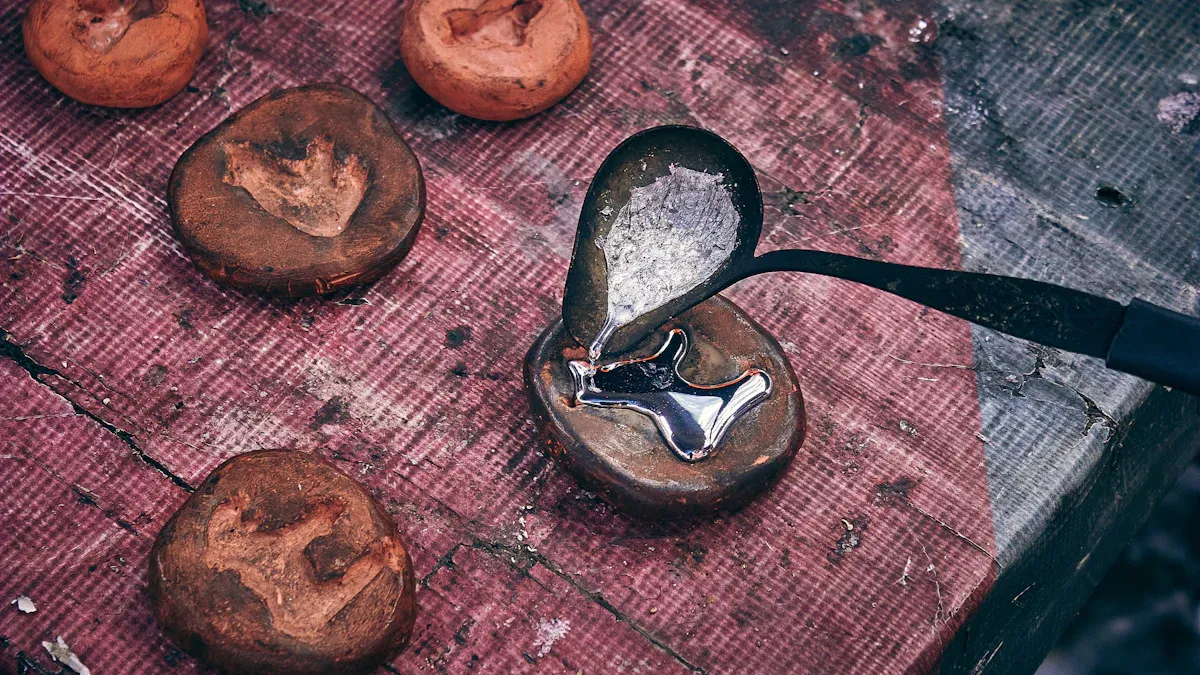
Engineers often select engineering investment castings for projects requiring tight tolerances, complex geometries, and smooth finishes. This process accommodates a variety of materials, including steel and enginnering investment cast alloy. However, engineering investment castings tend to have higher costs and longer lead times. The table below outlines the main advantages and disadvantages associated with engineering precision investment castings:
| Advantages | Disadvantages |
|---|---|
| High accuracy, intricate shapes, wide material range | Costly tooling, complex process, slow turnaround |
Key Takeaways
- Investment casting creates precise parts with complex shapes and smooth surfaces, reducing the need for extra machining and saving time.
- This process works best for small to medium production runs but can be costly and take longer than other casting methods.
- Engineers should choose investment casting when tight tolerances, special materials, and detailed designs are essential for their projects.
What Is Engineering Investment Castings?
Basic Process Overview
Investment casting, sometimes called lost-wax casting, uses a detailed process to create precise metal parts. Here’s how it works:
- A master pattern is made to match the final part exactly. This pattern helps create wax copies.
- Hot wax is injected into the master die, forming wax patterns. These patterns can be grouped together for multiple castings.
- Each wax pattern gets dipped in a ceramic or silica slurry. This step repeats several times to build a strong mold shell.
- The wax is melted out by heating, leaving a hollow ceramic mold.
- Workers pour molten metal into the hot mold. The metal fills every detail, even tiny sections.
- After cooling, the ceramic shell is broken away. If several parts were cast together, they get separated.
- The castings are cleaned and finished. Sometimes, extra hand work or welding is needed for final touches.
Tip: This process allows for very fine details and smooth surfaces, making it popular for parts that need high precision.
Why Engineers Use Investment Casting
Engineers often pick investment casting for its unique benefits:
- It creates parts that need little or no extra machining.
- The process delivers tight tolerances, often within +/- 0.005 inch per inch.
- Many alloys work with this method, including steel, stainless steel, and nickel.
- Tooling costs stay low because aluminum molds last a long time.
- Complex shapes, like gears or logos, are possible without extra steps.
- Less machining means less metal waste.
- Each batch of parts stays consistent in quality.
- The process supports both small and large production runs.
- Wax patterns can be reused, making it more eco-friendly.
Engineering investment castings help engineers design parts with tricky shapes and fine details. This method also keeps costs down by reducing the need for extra finishing.
Advantages of Engineering Investment Castings
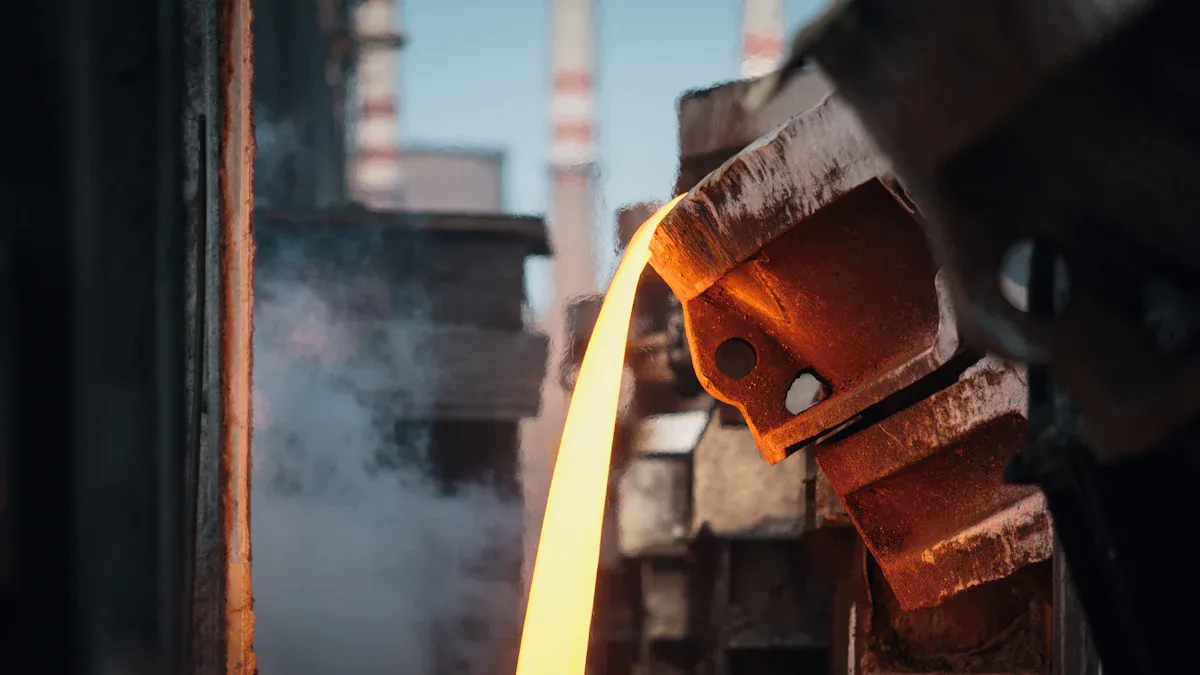
High Dimensional Accuracy and Precision
Engineers often choose investment casting when they need parts with tight tolerances. This process stands out for its ability to deliver high dimensional accuracy. For example, silica sol casting, a type of investment casting, can reach CT5-CT6 tolerances. That means for small parts, the process can hold tolerances as tight as ±0.18 mm. Even for larger parts, investment casting keeps tolerances within ±1.80 mm or about 1% of the dimension. These numbers beat most other casting methods.
| Casting Process | Tolerance Class | Tolerance (≤10 mm) | Tolerance (>250 mm) |
|---|---|---|---|
| Silica Sol Investment | CT5-CT6 | ±0.18 mm | ±1.80 mm |
| Water Glass Investment | CT7-CT8 | ±0.37 mm | ±2.70 mm |
| Lost Foam Casting | CT8-CT9 | ±0.60 mm | ±4.00 mm |
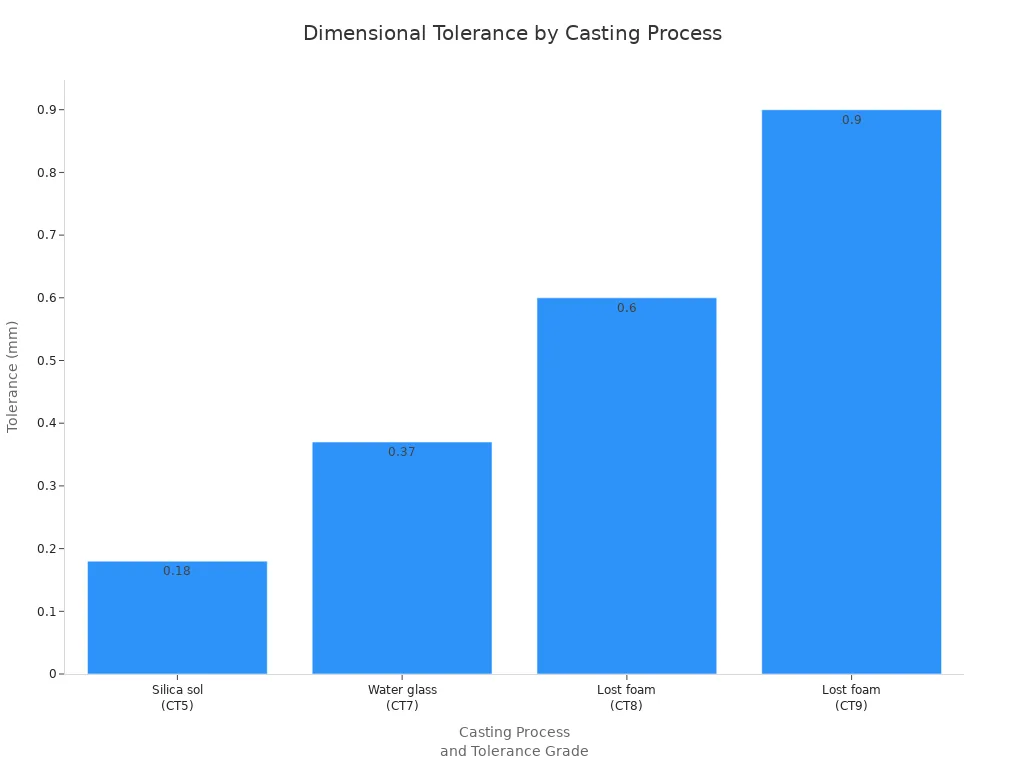
Note: Investment casting also controls geometric tolerances like flatness and roundness. Holes as small as 1/2 inch can have tolerances of ±0.003 inches (±0.076 mm). This level of precision helps engineers create parts that fit together perfectly.
Complex Geometries and Design Flexibility
Investment casting gives engineers the freedom to design parts with shapes that other methods cannot handle. The process uses a wax pattern coated in ceramic, which captures every detail. This allows for features like undercuts, thin walls, and internal channels. The ceramic mold holds its shape even at high temperatures, so the final part matches the original design closely.
Engineers can combine several parts into one casting. This reduces the number of joints and welds, making the part stronger and easier to assemble. Compared to sand casting or die casting, investment casting produces finer details and smoother surfaces. Industries like aerospace, automotive, and medical rely on this process for parts with complex shapes and tight tolerances.
Superior Surface Finish
Surface finish matters in many engineering applications. Investment casting delivers a much smoother surface than sand casting. The ceramic mold creates an “as-cast” finish that often needs little or no extra polishing. Typical surface roughness for investment casting ranges from 64 to 125 RMS. Sand casting, by comparison, usually produces rougher surfaces above 125 RMS.
| Casting Method | Typical Surface Roughness (RMS) | Notes on Surface Finish and Tolerances |
|---|---|---|
| Investment Casting | 64 – 125 | “As-Cast” finish; better surface finish than sand casting; complex shapes possible |
| Sand Casting | >125 | Rougher surface finish; less dimensional accuracy; larger tolerances |
| Plaster Casting | ~25 | Smoothest “As-Cast” finish among listed methods; closer tolerances |
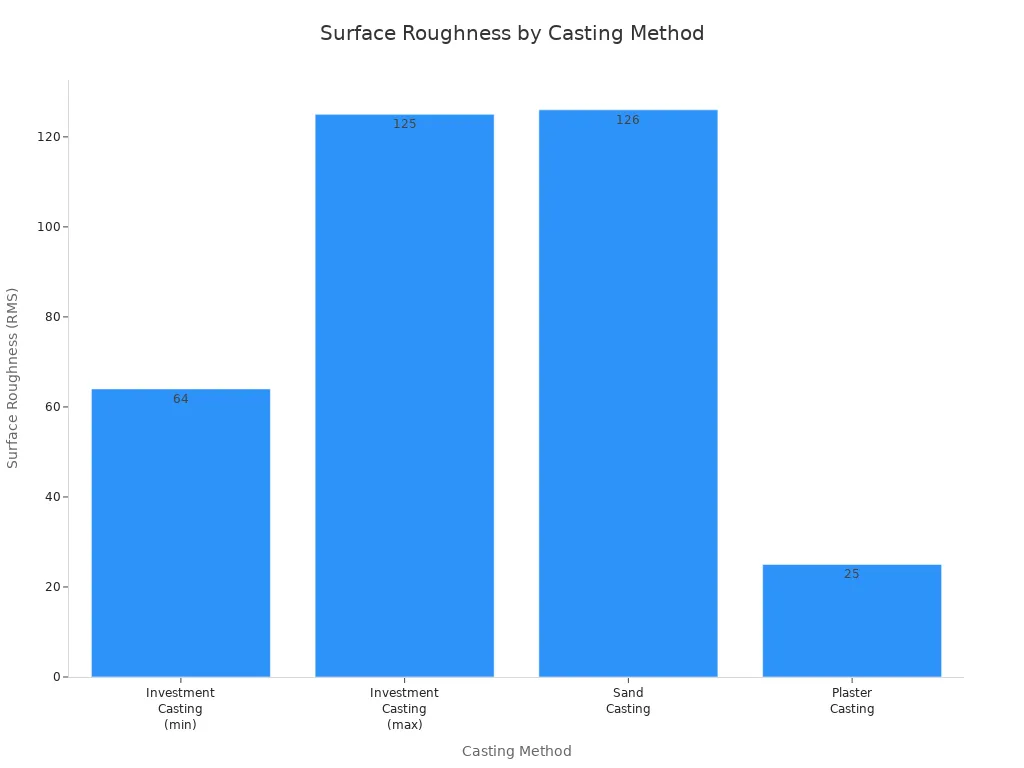
Tip: A smoother surface finish means less time spent on grinding or polishing. This can save money and speed up production.
Wide Material Compatibility
Investment casting works with a broad range of metals and alloys. Engineers can select materials that match the needs of their projects, from strength to corrosion resistance. Some of the most common materials include:
- Inconel® alloys
- Haynes® 230® alloy
- Hastelloy® C-276
- Stainless steels
- Refractory metals
- Titanium
These materials make engineering investment castings a top choice for industries like aerospace, power generation, automotive, and oil and gas. The process handles both standard and specialty metals, giving engineers more options for demanding applications.
Reduced Machining and Assembly Requirements
One of the biggest advantages of investment casting is its ability to produce near-net shape parts. This means the part comes out of the mold very close to its final dimensions. Engineers often find that they need little or no extra machining. The process also eliminates flash and parting lines, so there is less need for surface finishing.
| Aspect | Explanation |
|---|---|
| Dimensional Accuracy | Tight tolerances reduce the need for extra machining. |
| Surface Finish | Smooth surfaces often need no further finishing. |
| Complex Geometry | Intricate designs minimize additional machining. |
| Near-Net Shape Production | Parts come out close to final size, saving time and effort. |
| Reduced Assembly Adjustments | Better fit means less rework during assembly. |
| Time and Cost Savings | Fewer machining steps lower costs and speed up production. |
Modern investment casting shops often use advanced CNC machining to finish parts when needed. This integrated approach helps deliver complete-to-print parts, saving time and reducing complexity for engineers. By minimizing secondary machining, engineering investment castings help projects stay on schedule and within budget.
Disadvantages of Engineering Investment Castings
Higher Production Costs Compared to Alternatives
Investment casting delivers excellent precision, but it often comes with a higher price tag than other casting methods. Several factors drive up the cost:
- Tooling and mold creation require a significant upfront investment. Complex molds and intricate designs increase both time and expense.
- Material costs can vary widely. Premium alloys like stainless steel or specialty metals cost more than basic cast iron.
- Design complexity adds to labor and finishing costs. Intricate shapes need more attention during mold making and finishing.
- The number of shell layers needed for the ceramic mold increases with part size and complexity, raising both material and labor costs.
- Labor costs include skilled workers for mold making, casting, finishing, and quality control.
- Scrap and rework can add hidden costs, especially if the yield rate is low.
- Production volume affects cost per part. Higher volumes help spread out the fixed costs, but small runs keep the per-part price high.
Note: The cost per part drops as production volume increases, but for low to medium runs, investment casting remains more expensive than sand or die casting.
Longer Lead Times and Process Complexity
Engineers often face longer lead times when choosing investment casting. The process involves many steps, from creating wax patterns to building ceramic shells and finishing the final part. Each step takes time and requires careful attention.
The typical lead time for investment casting, from design to finished part delivery, ranges from 8 to 12 weeks. Automotive projects may finish in 8 to 10 weeks, while aerospace parts often take the full 12 weeks due to stricter requirements and more complex designs. This extended timeline can slow down project schedules, especially when compared to faster methods like die casting.
The process itself is complex. Each mold is single-use, so workers must repeat the mold-making steps for every part. This adds to both the time and the risk of errors. If a defect appears, the process may need to start over, causing further delays.
Size and Weight Limitations
Investment casting works best for small to medium-sized parts. While some facilities can produce large castings, most shops focus on parts weighing up to 20 pounds (about 9 kilograms). Expanded capabilities allow for parts up to 120 pounds (about 54 kilograms), but these are less common.
| Parameter | Details |
|---|---|
| Minimum part weight | Fraction of an ounce (e.g., dental braces) |
| Maximum part weight | Over 1,000 lbs (453.6 kg) for complex aerospace parts (rare) |
| Typical max weight (U.S.) | Up to 20 lbs (9.07 kg) in most facilities |
| Expanded capability range | 20-120 lbs (9.07-54.43 kg) becoming common |
| Weight for large castings | Up to about 800 Newtons (~81.6 kg) |
| Minimum wall thickness | Approximately 0.3 mm |
| Minimum hole diameter | Approximately 0.5 mm |
| Limiting factors | Mold handling equipment and facility capabilities |
Performance remains strong for parts up to about 25 pounds and 18 inches in length or width. Larger castings are possible, but they become less cost-effective and less common. Other casting methods, like sand casting, may offer better value for very large or heavy parts.
Limited Suitability for High-Volume Production
Investment casting is not the best choice for high-volume manufacturing. The process requires a new mold for every part, which slows down production. In contrast, die casting uses reusable steel molds and high-pressure injection, allowing for much faster cycle times.
- Investment casting has a longer cycle time because each mold is single-use.
- Die casting is optimized for high-volume runs, making it more efficient for mass production.
- Engineering investment castings work best for low to medium production volumes, where design complexity and precision matter more than speed.
Tip: For projects that need thousands or millions of identical parts, die casting or other high-speed methods usually offer better efficiency and lower costs.
Engineering Investment Castings vs. Other Casting Methods
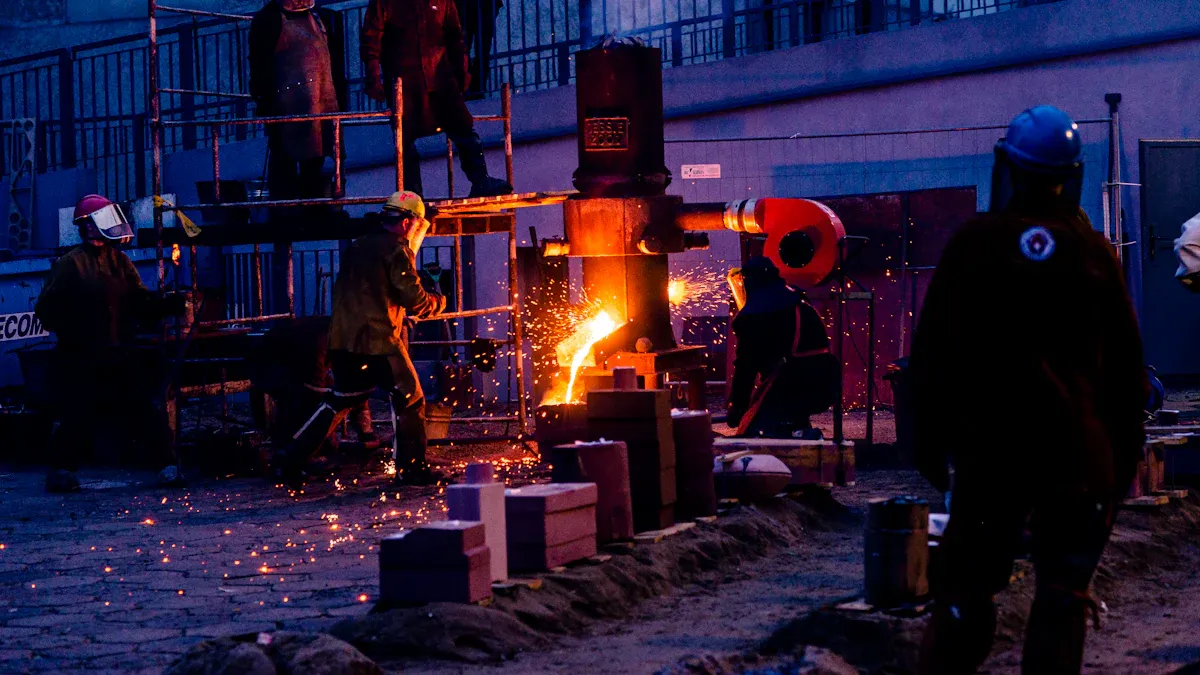
Comparison with Sand Casting
Sand casting and investment casting both create metal parts, but they offer different results. Sand casting uses sand molds, which can leave rough surfaces and less precise shapes. Investment casting uses ceramic molds, which capture fine details and produce smoother finishes. The table below highlights the main differences:
| Property | Investment Casting | Sand Casting |
|---|---|---|
| Surface Finish | Smooth surfaces, minimal secondary machining needed | Rough surfaces with parting lines, often require additional finishing |
| Dimensional Accuracy | High precision, fine tolerances | Lower precision, more variability |
| Mechanical Properties | Superior mechanical properties due to better alloys and controlled process | Variable mechanical properties due to porous molds and less controlled cooling |
| Complexity of Shapes | Can produce intricate, complex shapes with thin walls | Limited by mold removal constraints, draft angles needed |
Engineers often choose investment casting when they need parts with tight tolerances and complex shapes.
Comparison with Die Casting
Die casting and investment casting both make precise parts, but they suit different needs. Die casting uses reusable steel molds and works best for high-volume runs. Investment casting uses single-use molds and fits small to medium batches. Here’s a quick comparison:
| Aspect | Investment Casting (IC) | Die Casting (DC) |
|---|---|---|
| Total Cost | Generally higher due to manual process and precision | Lower per part in high volumes but higher tooling cost |
| Tooling Cost | Lower tooling costs | Higher tooling costs |
| Production Volume | Suitable for small to medium runs | Most cost-efficient for high-volume production |
| Lead Time (Tooling) | Shorter initial tooling lead time | Longer initial tooling lead time |
| Lead Time (Per Part) | Higher per-part production time | Faster per-part production after tooling setup |
| Surface Finish | Superior finish, less secondary machining needed | Good finish but usually requires secondary machining |
| Precision & Complexity | Excellent precision, ideal for complex geometries | Good dimensional tolerance, less complex parts |
When Investment Casting Is Preferable
Engineers pick investment casting for certain situations:
- They need parts with complex shapes and fine details.
- The project uses high melting point metals like stainless steel or titanium.
- The design calls for a smooth surface and little extra machining.
- The part must have strong internal and external features, such as those in aerospace or medical devices.
Investment casting shines when precision and complexity matter most.
When Alternative Methods Are Better
Other casting methods work better for some projects:
- Sand casting or 3D printed molds fit basic, solid shapes like engine blocks or hardware.
- These methods save money and speed up pattern production for simple parts.
- Die casting suits high-volume runs of less complex parts, such as automotive components or toys.
- Shell molding and gravity die casting help with larger quantities or small, simple parts.
- Lost foam casting works well for thin-walled or intricate products in many industries.
For large, simple, or high-volume parts, engineers often choose alternatives over engineering investment castings.
Common Defects and Limitations in Engineering Investment Castings
Typical Defects to Watch For
Defects can show up in any casting process, and investment casting is no exception. Engineers often look for certain issues that can affect part quality and performance. Here’s a quick table that highlights the most common defects, what causes them, and why they matter:
| Defect Type | Description | Effects/Consequences |
|---|---|---|
| Porosity | Gas bubbles form during pouring or solidification. | Can cause leaks, making parts unsuitable for pressure applications like pumps and compressors. |
| Shrinkage/Voids | Cracks or breaks from metal shrinking as it cools. | May lead to structural failure or breakage. |
| Non-Metallic Inclusions | Foreign materials (slag, sand, or ceramic) get trapped in the metal. | Weaken the casting and reduce integrity. |
| Linear Indications | Cracks, hot tears, or cold shuts appear as lines on the surface. | Compromise strength and may cause breakage. |
| Rough/Decarburized Surface | Surface texture issues, though less common due to ceramic molds and controlled atmosphere. | Usually improved in investment casting, but can affect machinability and appearance. |
Defects like porosity and inclusions are fairly common. Porosity often appears in thick sections or where metal cools last. Even with good foundry practices, some bubbles or inclusions can sneak in. Most commercial castings have a little internal porosity, and engineers use tests like X-ray or ultrasonic inspection to find them. Zero-porosity parts are possible, but they need extra steps like Hot Isostatic Pressing.
Process Limitations Impacting Engineering Projects
Several process limitations can impact how well engineering investment castings perform in real-world projects:
- Complex part designs may need special molding techniques, which can increase cost and risk of defects.
- Material choice affects which alloys can be used and how strong or durable the final part will be.
- Mold design, including how metal flows and cools, plays a big role in preventing defects.
- Tight casting tolerances are possible, but they depend on careful process control.
- The rate at which metal solidifies can lead to shrinkage or porosity if not managed well.
- Mold material and its lifespan influence surface finish and thermal control.
- Pouring temperature and speed affect how well the metal fills the mold.
- Batch size and casting volume can limit which equipment or process is best.
- Post-casting steps like heat treatment or machining also affect the final part’s performance.
Engineers should always consider these factors when deciding if investment casting is the right fit for their project. Some limitations are just part of the process, but understanding them helps avoid surprises down the road.
Practical Considerations for Engineers
When to Choose Investment Casting
Engineers often wonder when investment casting makes the most sense. This process works best for parts that need tight tolerances and complex shapes. If a project calls for a smooth surface or uses specialty metals, investment casting stands out. Many engineers pick this method for aerospace, medical, or energy parts. These industries need high performance and reliability.
A good rule of thumb:
Choose investment casting when the design is too detailed for sand casting or when machining would waste too much material.
Small to medium production runs also fit well. If a team needs only a few hundred parts, investment casting can save time and money compared to other methods.
Key Factors to Evaluate Before Selecting
Before choosing investment casting, engineers should look at a few key points:
- Part Complexity: Does the design have thin walls, undercuts, or fine details?
- Material Needs: Will the part use high-performance alloys or metals?
- Production Volume: Is the order size small or medium?
- Budget and Lead Time: Can the project handle higher costs and longer wait times?
- Quality Requirements: Does the part need a smooth finish or tight tolerances?
The table below helps engineers compare these factors:
| Factor | Investment Casting | Other Methods |
|---|---|---|
| Complex Shapes | Excellent | Limited |
| Surface Finish | Smooth | Rougher |
| Volume Flexibility | Good (low/medium) | Best (high volume) |
By weighing these points, engineers can decide if engineering investment castings match their project goals.
Engineers see clear benefits with engineering investment castings. The process delivers tight tolerances, smooth finishes, and complex shapes. It works best for thin-walled, high-precision parts in aerospace or medical fields. However, longer cycles, higher costs, and possible defects mean careful planning always matters.
FAQ
What industries use investment casting the most?
Aerospace, automotive, medical, and energy industries rely on investment casting. They need parts with tight tolerances, complex shapes, and high performance.
Can investment casting handle large parts?
Most shops focus on small to medium parts. Some facilities can cast larger pieces, but sand casting usually works better for very big components.
How does investment casting reduce waste?
Investment casting creates near-net shape parts. This means less extra material gets cut away, so engineers see less scrap and lower material costs.
